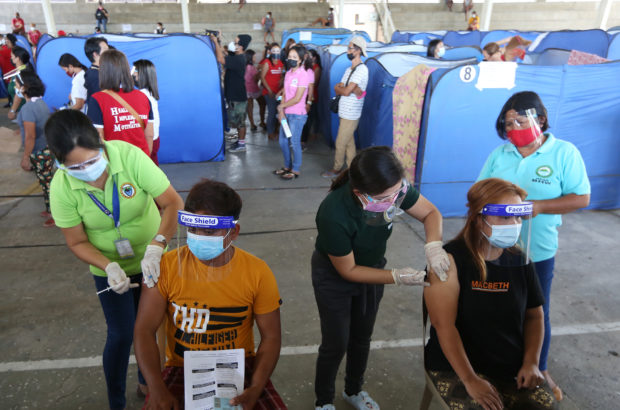Gov’t starts vaccinating Taal evacuees

PROTECTION Several residents displaced by the activity of Taal Volcano receive their first dose of the Sinovac vaccine at Plaza Elena evacuation center in Agoncillo, Batangas province, on Monday as the government ensures that evacuees will be protected against COVID-19. —NIÑO JESUS ORBETA
MANILA, Philippines — Around 40 Taal evacuees received their first dose of the COVID-19 vaccine on Monday as part of the government’s efforts to prevent an outbreak in crowded evacuation centers.
Health Secretary Francisco Duque III led the vaccination drive at Sta. Elena Plaza and Pook Elementary School in Agoncillo town, Batangas province, which were being used as temporary shelters for residents displaced by the restive volcano. One of those who received the jab was Agoncillo Mayor Daniel Reyes.
Dr. Rose Ozaeta, Batangas health officer, said that only 40 evacuees from the town were inoculated because the other eligible recipients were not around.
“[We] will continue [the vaccination] this week,” Ozaeta said in a text message.
Metro LGUs donate vaccines
Dr. Voltaire Guadalupe from the Department of Health in the Calabarzon (Cavite, Laguna, Batangas, Rizal and Quezon) region told reporters that there were enough test kits and vaccines for people in temporary shelters, adding that everyone above 18 would be inoculated.
Article continues after this advertisementThose known to be infected with COVID-19 have been isolated and no new cases have been reported, he said.
Article continues after this advertisementAround 7,500 doses of the Sinovac vaccine have been donated by the local governments of Quezon City, Mandaluyong, Taguig, Manila, Marikina and Parañaque for the inoculation drive.
“These are not surplus [vaccines]. They were going to use these but they decided that the people of Batangas need these more because people might gather in one place during an evacuation. They should be vaccinated first,” Metropolitan Manila Development Authority (MMDA) chair Benhur Abalos said at the Laging Handa briefing.
Abalos said the MMDA had informed Defense Secretary Delfin Lorenzana that it was ready to send personnel, firetrucks, generators, floodlights and tents to Batangas to help those staying in shelters.
Social Welfare Secretary Rolando Bautista also assured evacuees and affected residents that there were enough funds to provide them aid.
According to him, his department’s field offices have a stockpile of food and nonfood items, and standby funds totaling P1.08 billion.
As of July 4, some 1,200 families, or 4,500 individuals, were affected by Taal Volcano’s restiveness, Bautista said.
Of the 4,500 people, 2,000 were in 16 evacuation centers while the rest were staying with their relatives or friends in nearby areas, he said.
More volcanic quakes
Volcanic earthquakes this week continued to rock Taal Volcano which remained under heightened alert for a possible eruption.
The Philippine Institute of Volcanology and Seismology (Phivolcs) said the Taal Volcano Network recorded 17 volcanic quakes between Sunday and Monday, including 16 low-frequency quakes and a volcanic tremor that lasted for 45 minutes.
Government volcanologists said that volcanic sulfur dioxide (SO2) gas emissions in the volcano remained high. The main crater also spewed steam-rich plumes that rose up to 2,500 meters high.
Over the weekend, SO2 emission averaged 22,628 tons per day, the highest ever recorded in Taal.
Phivolcs said that at alert level 3, which signified magmatic unrest, magma or hot molten rock was being pushed out of Taal’s main crater, and could lead to an explosive eruption.
Volcanologists once again reminded communities around Taal Lake to remain vigilant and to take precautionary measures against possible airborne ash and volcanic smog.
Taal was placed on heightened alert last week, following a five-minute phreatomagmatic eruption, which occurred due to the interaction of rising magma and water in the main crater lake.
Phivolcs officer in charge Renato Solidum said an increase in volcanic activity, such as quakes and SO2 emissions, could raise the alert status in Taal. Should the activities decrease in two weeks, however, volcanologists might consider lowering the alert status.
Prepared
Alma Trinidad, a resident of Tagaytay City, has been having difficulty sleeping over the past days due to fears that Taal may erupt while she and her brood of five teenagers are sleeping.
“I’m having anxiety attacks. I had to take sleeping pills every night to calm me down,” Trinidad said. “I get scared when night falls because I’ve been thinking that if the volcano erupts at nighttime, we will find it difficult to evacuate.”
Just in case they need to leave in a hurry, each family member has packed a bag containing clothes and other essential stuff.
Francis Tan, 34, another resident who travels daily to Carmona town in Cavite province where he works as a car salesman, said they had gotten used to the rumblings of the volcano “but the extreme fear still lingers on.”
Like Trinidad, he said his family’s “emergency bags are always ready; just in case.”